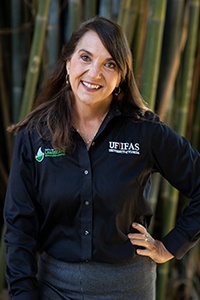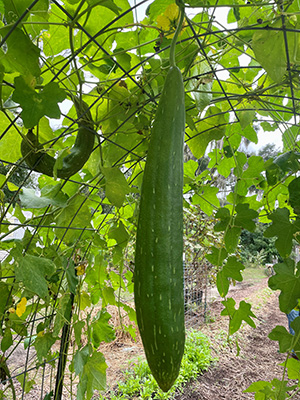Wendy’s Wanderings

Luffa Squash
October 2025
This is the time of year when we see pumpkins and gourds in stores and fall displays. Last week, while touring a community garden, I was reminded of another large squash — because I bonked my head on it as I walked under an arbor! It was a luffa, about three feet long, and it saw me before I saw it. If you have some vertical space in your garden, consider growing this fascinating cucurbit. The luffa is unique because it can be eaten when young, and when mature and dried, it transforms into a biodegradable sponge. If you haven’t grown luffa before, plan to include it in next year’s spring or summer garden.
The farm I grew up on in South Florida always had a luffa vine climbing along a fence, trellis or even up a tree. Two types of luffa can be grown in Florida, the angled luffa (Luffa acutangula) and the smooth luffa (L. aegyptica). Both grow on long, climbing vines similar to cucumbers. They are vigorous growers, producing vines as long as 30 feet and bright yellow flowers that attract pollinators. The squash starts out looking like a cucumber but keeps growing — sometimes up to two feet long and five inches wide!

Wendy Wilber.
Luffa is a warm-season vegetable, so plant seeds from March through July in a full-sun location with well-drained soil. Trellising is essential to support the sprawling vines and heavy fruit. Look for improved cultivars such as ‘Smooth Boy’, ‘Smooth Beauty’ and ‘Smooth Winner’. For the angled luffa, try ‘Lucky Boy’, ‘Summer Long’ or ‘Hybrid Asian Pride’. Seeds are often shared among gardeners, but ask your source if they know the cultivar name.
If you plan to eat your luffa squash, harvest the fruit when it’s less than six inches long. At this stage, it tastes like a mild zucchini, tender and slightly sweet. If it’s the sponge feature you’re after, allow the squash to grow to full maturity. You’ll know it’s ready when the skin turns tan and dry. Pick it from the vine and let it dry further in the sun. The outer skin will peel off easily, revealing the fibrous inner sponge. Cut off one end, shake out the seeds, then soak the sponge overnight in a mild bleach solution before setting it out to dry in the sun. Once dry, your homegrown sponge is ready to use!
For more information on growing luffa, visit:
Luffa squash is both practical and charming — a garden plant that feeds you in summer and scrubs your dishes in winter. With its climbing habit and dual purpose, it’s a rewarding addition to any Florida garden.
